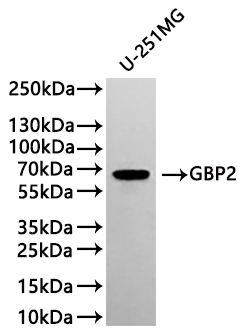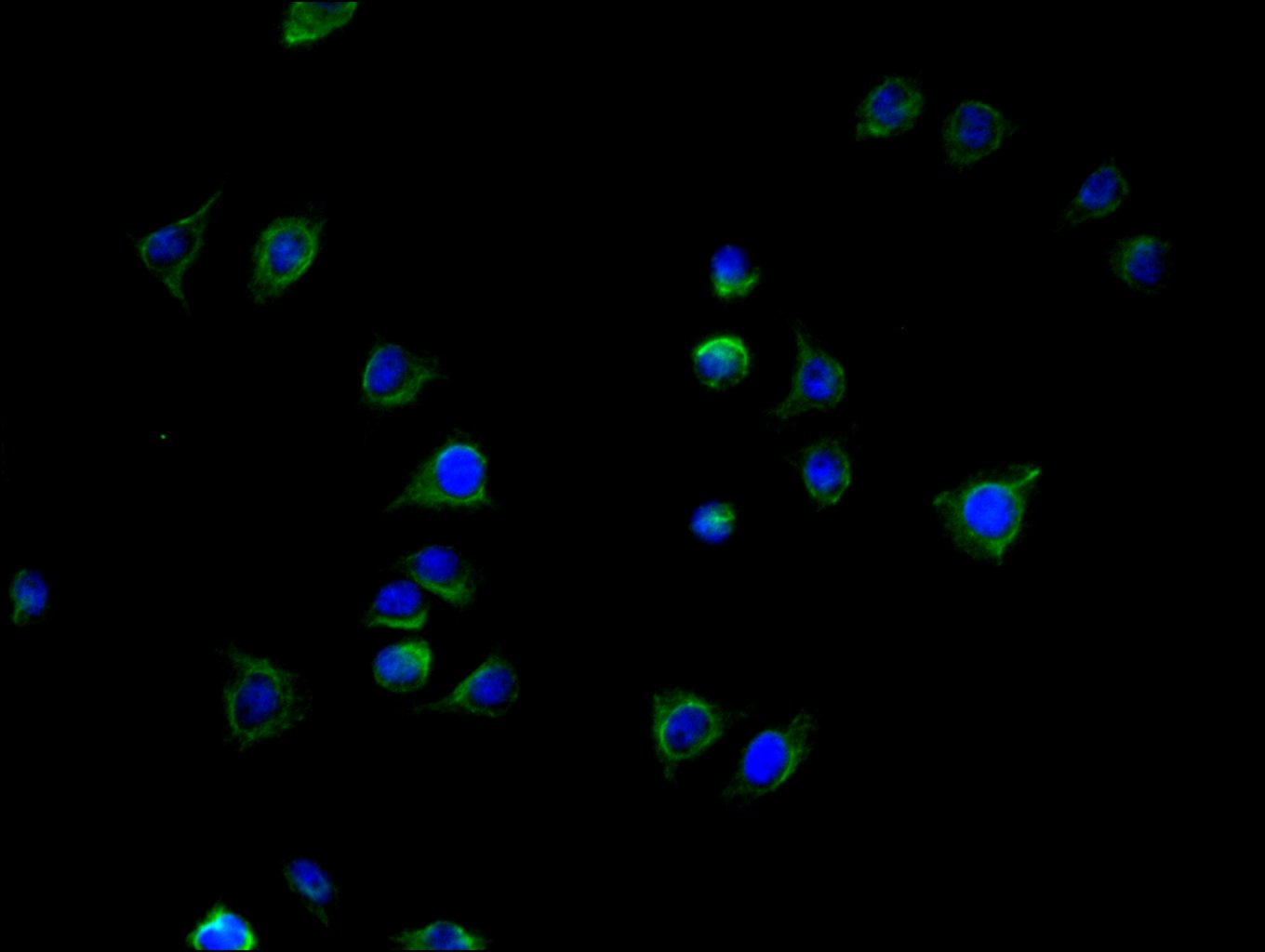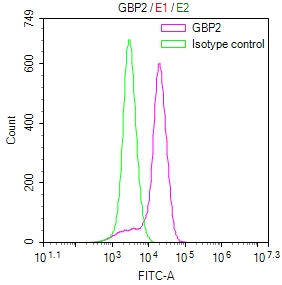GBP2 Recombinant Monoclonal Antibody
-
中文名稱:GBP2 Recombinant Monoclonal Antibody
-
貨號:CSB-RA009298MA1HU
-
規(guī)格:¥1320
-
圖片:
-
Western Blot
Positive WB detected in: U-251MG whole cell lysate(20μg)
All lanes: GBP2 antibody at 1:1000
Secondary
Goat polyclonal to rabbit IgG at 1/40000 dilution
Predicted band size: 67 kDa
Observed band size: 67 kDa
Exposure time:2min -
Immunofluorescence staining of Hela cell with CSB-RA009298MA1HU at 1:30 counter-stained with DAPI. The cells were fixed in 4% formaldehyde, permeabilized using 0.2% Triton X-100 and blocked in 10% normal Goat Serum. The cells were then incubated with the antibody overnight at 4°C. The secondary antibody was Alexa Fluor 488-congugated AffiniPure Goat Anti-Human IgG(H+L).
-
Overlay Peak curve showing A431 cells stained with CSB-RA009298MA1HU (red line) at 1:100. The cells were fixed in 4% formaldehyde and permeated by 0.2% TritonX-100 for?10min. Then 10% normal goat serum to block non-specific protein-protein interactions followed by the antibody (1ug/1*106cells) for 45min at 4℃. The secondary antibody used was Fluorescein (FITC) AffiniPure Goat Anti-Human IgG, Fcγ fragment specific at 1:200 dilution for 35min at 4℃.Control antibody (green line) was human IgG1 (1ug/1*106cells) used under the same conditions. Acquisition of >10,000 events was performed.
-
-
其他:
產(chǎn)品詳情
-
Uniprot No.:
-
基因名:
-
別名:GBP2Guanylate-binding protein 2 antibody; EC 3.6.5.- antibody; GTP-binding protein 2 antibody; GBP-2 antibody; HuGBP-2 antibody; Guanine nucleotide-binding protein 2 antibody; Interferon-induced guanylate-binding protein 2 antibody
-
反應(yīng)種屬:Human
-
免疫原:Recombinant Human GBP2 protein
-
免疫原種屬:Homo sapiens (Human)
-
標(biāo)記方式:Non-conjugated
-
克隆類型:Monoclonal
-
抗體亞型:hIgG1
-
純化方式:Affinity-chromatography
-
克隆號:1H6F9
-
濃度:It differs from different batches. Please contact us to confirm it.
-
保存緩沖液:Preservative: 0.03% Proclin 300
Constituents: 50% Glycerol, 0.01M PBS, PH 7.4 -
產(chǎn)品提供形式:Liquid
-
應(yīng)用范圍:ELISA, WB, IF, FC
-
推薦稀釋比:
Application Recommended Dilution WB 1:500-1:2000 IF 1:50-1:200 FC 1:50-1:200 -
Protocols:
-
儲存條件:Upon receipt, store at -20°C or -80°C. Avoid repeated freeze.
-
貨期:Basically, we can dispatch the products out in 1-3 working days after receiving your orders. Delivery time maybe differs from different purchasing way or location, please kindly consult your local distributors for specific delivery time.
-
用途:For Research Use Only. Not for use in diagnostic or therapeutic procedures.
相關(guān)產(chǎn)品
靶點詳情
-
功能:Hydrolyzes GTP to GMP in 2 consecutive cleavage reactions, but the major reaction product is GDP. Exhibits antiviral activity against influenza virus. Promotes oxidative killing and delivers antimicrobial peptides to autophagolysosomes, providing broad host protection against different pathogen classes.
-
基因功能參考文獻(xiàn):
- Study presents the first demonstration that GBP2 inhibits mitochondrial fission and cell metastasis in breast cancer cells both in vitro and in vivo. PMID: 29072687
- Low GBP2 expression is associated with metastasis in breast cancer. PMID: 23001506
- Downregulation of MIR-433 is associated with myeloproliferative neoplasms. PMID: 22864358
- The in vivo localization of GBP-2 at cellular membranes is regulated by isoprenylation and dimerization. PMID: 21151871
- Guanylate-binding protein 2 mRNA in peripheral blood leukocytes may have a role in acute cellular rejection after liver transplantation PMID: 19912588
- Sky1p utilizes the same docking groove to bind yeast SR-like protein Gbp2p and phosphorylates all three serines present in a contiguous RS dipeptide stretch PMID: 17517895
- GBP-2 is regulated by p53 and may have a role in esophageal squamous cell carcinomas PMID: 19003964
顯示更多
收起更多
-
亞細(xì)胞定位:Cytoplasm. Cytoplasm, perinuclear region. Golgi apparatus membrane. Membrane; Lipid-anchor.
-
蛋白家族:TRAFAC class dynamin-like GTPase superfamily, GB1/RHD3-type GTPase family, GB1 subfamily
-
數(shù)據(jù)庫鏈接:
Most popular with customers
-
-
Phospho-YAP1 (S127) Recombinant Monoclonal Antibody
Applications: ELISA, WB, IHC
Species Reactivity: Human
-
-
-
-
-
-






















